699 Search Results for communication book
December 7, 2017
by Carole Zangari -
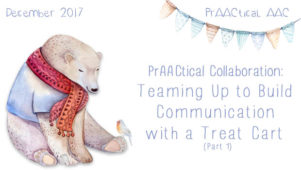
Looking for ways to give your AAC learners the opportunity to communicate with a broader range of communication partners? Interested in practicing AAC skills outside of the classroom? When I saw this fun learning experience that SLP Kimberly Walker and her colleagues developed, I knew it would spark the imaginations of some of our prAACtical friends. I am continually amazed by the creativity of teachers, SLPs, OTs, and others who are passionate about helping students become more proficient with their AAC and language. Based in Colorado, Kimberly works with students in kindergarten through grade 5 at Tarver Elementary. In this post, she explains how they set up a Treat Cart in order to spice up the opportunities for AAC, language, and literacy learning. ——————————————————— Finding ways for our AAC users to see the power of communication by using their AAC device is hard at times. My Occupational Therapist and I... [Read More...]
October 25, 2017
by Carole Zangari -
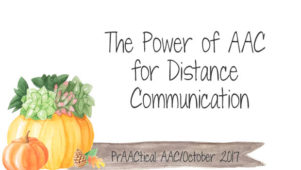
Today, we look to South Africa to learn from AT specialist Desirae Pillay who shares her thoughts on using AAC for communicating at a distance. In an earlier post, Desirae shared her experience as an AAC parent. In the current post, she talks about things we don’t always think about when supporting people with AAC needs. The Power of AAC for Distance Communication I am an Assistive Technology Advisor for a company in South Africa and a parent to a young adult, Savannah Pillay who is cerebral palsied and autistic. As an advisor, it is my job to know of all the communication options that are available which includes knowing about unaided AAC options. I am a big fan of gesture dictionaries as I have seen how impactful it can be especially when using a multi-modal communication system. I am also a fan of AAC software that not only has... [Read More...]
October 18, 2017
by Carole Zangari -
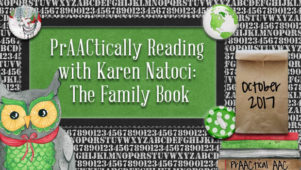
Today, we welcome back SLP Karen Natoci who is resuming her wonderful series on interactive book reading with AAC learners. Karen has supported AAC learners in different capacities throughout her career and is currently an AAC Supervisor with The Speech Pathology Group in Walnut Creek, California. You can read more about Karen at the end of her post and explore some of her previous posts here. PrAACtically Reading Book: The Family Book Written and Illustrated by Todd Parr (2003); Little, Brown and Company, Hachette Book Group AAC Competency Areas: Linguistic: Core Vocabulary Focus: big, small, same, different, like, help, my, I, Fringe Vocabulary focus: you, me, family, families, mom, dad, sister, brother (their names) Math Concept: concept of 1, more than 1, 1 versus 2, Actions: eat, noise/quiet, clean/messy Syntax: provide co-construction support, model same + one word more Strategic: Students will express a variety of communicative modalities to gain attention, and share... [Read More...]
September 18, 2017
by Carole Zangari -
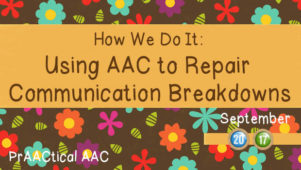
We’ve had many nice comments about the resources shared by AAC SLP Alicia Garcia, clinical lead of the AAC Clinic at One Kids Place, a children’s treatment centre in northern Ontario. With over two decades of experience in pediatric rehabilitation practice in private and public settings, Alicia’s ideas for how to support AAC learners and their families are tried and true. In today’s post, Alicia shares thoughts and materials for situations in which the AAC is needed to repair communication breakdowns. :::::::::::::::::::::::::::::::::::::::::::::::::::::::::::::::::::::::::::::::::::::::::::::::: Children with unclear speech not only have different intelligibility levels but also different levels of awareness, focus, and interest on repairing their communication breakdowns. We use different approaches based on how they react and respond when they are not understood. As a general guideline when a communication breakdown occurs, regardless of the child’s profile, we first try determining the level of urgency or importance of the child’s intended... [Read More...]
April 24, 2017
by Carole Zangari -
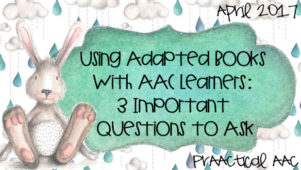
We’re seeing a big increase in the number of families and professionals who are prioritizing literacy instruction for people with AAC needs, and that makes us VERY happy. In some cases, families, teachers, and therapists are using adapted books in their shared reading activities and making them available for self-selected reading, too. There are lots of ways to adapt books, though, and not every adaptation is appropriate for an individual who uses or is learning AAC. In this post, we talk about some of the things to consider when making decisions about adapted books. The term ‘adapted book’ refers to a book that was altered in some fashion to make it more accessible to people with disabilities. There are different ways of modifying books including: Simplifying or revising the text, Adding AAC symbols to the text, Changing the format (e.g., cutting it apart, binding it at the top, and reassembling,... [Read More...]
January 12, 2017
by Carole Zangari -
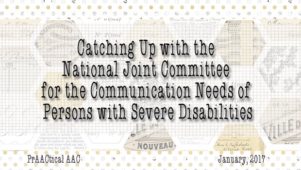
The NJC has been one of my go-to resources for many years, so I was delighted when Amy Goldman agreed to write an update on recent activities. Amy is one of my AAC heroes but you may know her best from her long career of advocacy with AAC and AT through professional organizations (e.g., ASHA, USSAAC, ATIA, PSHA, ATAP). Amy is now one of three technical assistance specialists with the national Assistive Technology Act Technical Assistance and Training Center (AT3). She recently retired from her position as Co-Executive Director of the Institute on Disabilities at Temple University, PA’s University Center of Excellence in Developmental Disabilities where she directed local, state, and federal projects related to assistive technology. She is honored to represent ASHA on the National Joint Committee for the Communication Needs of Persons with Severe Disabilities (NJC). She and I co-chair the ATIA strand on AAC and hope to see many... [Read More...]
November 15, 2016
by Carole Zangari -
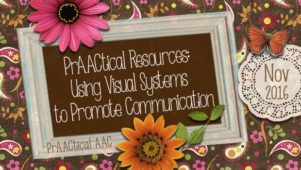
Looking for a handy guide to help families who are new to communication disability get familiar with visual supports for communication? In today’s post, we share a wonderful booklet intended just for that purpose. Australian SLP Dolly Bhargava created this book, Getting Started: Using Visual Systems to Promote Communication, with support from the School for Parents and the Non Government Centre Support for Non School Organisations of Western Australia. You can see the accompanying video here.
July 18, 2016
by Carole Zangari -
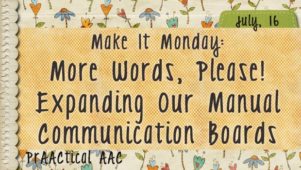
It’s another Make It Monday, our series on preparing core vocabulary materials for use with AAC learners. When we left off last week, we selected or created manual communication boards (MCBs) with a starter set of core words. Today, we pick up that thread by adding more words. If you are working with teams that are new to AAC implementation, have a difficult time with change, or are showing resistance to this “whole AAC thing,” you might want to start off slowly and use just the main communication board for a few weeks to build everyone’s confidence. You can add more words once they are implementing it fairly well. The way I see it: Strong implementation of a basic core board is better than weak implementation of a more robust board. It doesn’t take very long, though, to realize that as versatile as our core word MCB is, there simply... [Read More...]
July 11, 2016
by Carole Zangari -
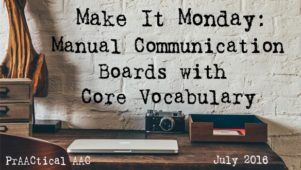
Welcome to Make It Monday, a series in which we hope to inspire your team to create communication boards and instructional materials for students who need or already use core vocabulary. In the first post, Getting Ready for a Core Vocabulary Journey, we talked about getting set up to make materials for expressive and receptive language use. Today, we get into making manual communication boards (MCBs). About Manual Communication Boards The term manual communication board refers to a ‘no-tech’ AAC support that students can use to express themselves. Typically printed on paper and laminated, most MCBs have grids of words organized by part of speech (e.g., verbs in one area, adjectives in another). MCBs that are designed for use in a particular activity, such as doing an art project or participating in Circle Time, are called activity-based communication displays, or ABCDs. ABCDs were very popular in the early days of... [Read More...]
April 18, 2016
by Carole Zangari -
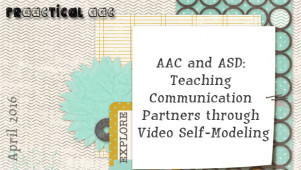
It is an honor to have Dr. Joanne Cafiero, an AAC consultant for individuals with complex communication needs and Autism Spectrum Disorders, as a guest contributor for today’s post. Dr. Cafiero is the author of Meaningful Exchanges for People with Autism an Introduction to AAC (2005). She is a consulting editor for Focus on Autism and Other Developmental Disabilities and has guest edited several of ASHA’s Perspectives in AAC. She was a member of the National Academy of Sciences Committee on Educational Interventions for Children with Autism (2001) and is currently working on an update on AAC and Autism for the Academy. In this post, she shares some of her work on video self-modeling. ::::::::::::::::::::::::::::::::::::::::::::::::: Growing research and first-person reports are illuminating the unique sensory and motor differences experienced by people on the Autism Spectrum. This new information has a huge impact on the AAC practitioner. Motor planning differences in ASD can... [Read More...]









